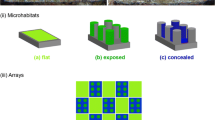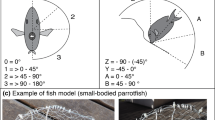Summary
Previous studies indicated that at Taboguilla Island (Gulf of Panama), persistence of many intertidal organisms depended on holes and crevices in the rock as refuges from both vertebrate (fishes) and invertebrate (crabs, gastropods, chitons) consumers. Here, we evaluate the influences of substratum heterogeneity and consumers on patterns of diversity of sessile organisms in this habitat. Local substratum topography is highly variable, ranging from smooth to irregular surfaces. Algal crusts typically dominate all low zone rock surfaces, and most other sessile spegies (invertebrates and foliose algae) occur in holes and crevices. Number (S) and diversity (H′) of sessile species is lower on homogeneous surfaces than on heterogeneous surfaces. Rate of increase in S with area sampled is positively correlated with substratum heterogeneity; number of species sampled per transect at a homogeneous site would be about 10 vs 30 to 60 on a heterogeneous site. Large fishes and crabs forage intensively over both substratum types, but cannot enter holes and crevices to eat prey. Gastropods, chitons, limpets, and small crabs feed on both substrata but vary in abundance from hole to hole. Prey mortality is thus intense and constant on open surfaces, but variable in space and time in holes and crevices. When consumers are excluded from the general rock surface, algal crusts are settled upon and overgrown by foliose algae, hydrozoans, and sessile invertebrates, particularly bivalves. Both S and H′ first increase, as sessile species invade and become more abundant, and then decrease as the rock oyster Chama echinata begins to outcompete other species and dominate primary space. Hence, consumers normally keep local diversity low by removing most sessile prey from open surfaces.
In these experiments, a consumer pressure gradient was established by removing 0, 1, 2, 3, and all of 4 distinct groups of consumers. As predicted by the intermediate disturbance hypothesis, lowest diversity occurred at lowest (total exclusion) and highest consumer pressure (normal condition). Highest diversity occurred at intermediate consumer pressure. Unexplained variation in this relationship is probably due to quantitative and qualitative differences in consumer regime, variation among plots in substratum heterogeneity, and insufficient time for competitive dominance by Chama to be fully expressed. On a small (0.25 m2) spatial scale, consumers maintain low diversity by keeping prey scarce and causing local extinctions. On larger spatial scales, they may maintain and even produce high diversity through their interaction with substratum heterogeneity and possibly low dispersal rates of sessile species.
Similar content being viewed by others
References
Abugov R (1982) Species diversity and phasing of disturbance. Ecology 63:289–293
Addicott JF (1974) Predation and prey community structure: an experimental study of the effect of mosquito larvae on the protozoan communities of pitcher plants. Ecology 55:475–492
Brock RE (1979) An experimental study on the effects of grazing by parrotfishes and role of refuges in benthic community structure. Mar Biol 51:381–388
Buss LW, Jackson JBC (1979) Competitive networks: nontransitive competitive relationships in cryptic coral reef environments. Am Nat 113:223–234
Caswell H (1978) Predator-mediated coexistence: a nonequilibrium model. Am Nat 112:127–154
Choat JH, Kingett PD (1982) The influence of fish predation on the abundance cycles of an algal invertebrate fauna. Oecologia (Berlin) 54:88–95
Connell JH (1961a) The influence of intraspecific competition and other factors on the distribution of the barnacle Chthamalus stellatus. Ecology 42:710–723
Connell JH (1961b) Effects of competition, predation by Thais lapillus, and other factors on natural populations of the barnacle Balanus balanoides. Ecol Monogr 31:61–104
Connell JH (1978) Diversity in tropical rain forests and coral reefs. Science 199:1302–1310
Crombie AC (1947) Interspecific competition. J An Ecol 16:44–73
Dayton PK (1971) Competition, disturbance, and community organization: the provision and subsequent utilization of space in a rocky intertidal community. Ecol Monogr 41:351–389
Gaines SD (1983) Diverse consumer guilds in intertidal communities of Oregon and the Republic of Panama and their effects on prey assemblages. PhD Thesis, Oregon State University, Corvallis, OR
Garrity SD, Levings SC (1981) A predator-prey interaction between two physically and biologically constrained tropical rocky shore gastropods: direct, indirect and community effects. Ecol Monogr 51:267–286
Garrity SD, Levings SC (1983) Homing to scars as a defense against predators in the pulmonate limpet Siphonaria gigas (Gastropoda). Mar Biol 72:319–324
Gause GF (1934) The struggle for existence. Williams and Wilkins, Baltimore
Harper JL (1969) The role of predation in vegetational diversity. Brookhaven Symp in Biol 22:48–62
Harper JL (1977) Population biology of plants. Academic Press, New York, NY
Hastings A (1978) Spatial heterogeneity and the stability of predator-prey systems: predator-mediated coexistence. Theor Pop Biol 14:380–395
Hastings A (1980) Disturbance, coexistence, history and competition for space. Theor Pop Biol 18:363–373
Hixon MA (1980) Competitive interactions between California reef fishes of the genus Embiotoca. Ecology 61:918–931
Holbrook SJ (1979) Habitat utilization, competitive interactions and coexistence of three species of cricetine rodents in eastcentral Arizona. Ecology 60:758–769
Holmes RT, Bonney Jr RE, Pacala SW (1979) Guild structure of the Hubbard Brook bird community: a multivariate approach. Ecology 60:512–520
Huffaker CB (1958) Experimental studies on predation: dispersion factors and predator-prey oscillations. Hilgardia 27:343–383
Huston M (1979) A general hypothesis of species diversity. Am Nat 113:81–101
Jackson JBC (1977) Competition on marine hard substrata: the adaptive significance of solitary and colonial strategies. Am Nat 111:743–767
Kohn AJ (1961) The ecology of Conus in Hawaii. Ecol Monogr 29:47–90
Kohn AJ (1967) Environmental complexity and species diversity in the gastropod genus Conus on Indo-West Pacific reef platforms. Am Nat 101:251–259
Larson RJ (1980) Competition, habitat selection and the bathymetric segregation of two rockfish (Sebastes) species. Ecol Monogr 50:221–239
Levings SC, Garrity SD (1983) Diel and tidal movement of two co-occurring neritid snails: differences in grazing patterns on a tropical rocky shore. J Exp Mar Biol Ecol 67:261–278
Lubchenco J (1978) Plant species diversity in a marine intertidal community: importance of herbivore food preference and algal competitive abilities.Am Nat 112:23–39
Lubchenco J (1980) Algal zonation in the New England rocky intertidal community: an experimental analysis. Ecology 61:333–344
Lubchenco J (1983) Littorina and Fucus: Effects of herbivores, substratum heterogeneity, and plant escapes during succession. Ecology 64:1116–1123
Lubchenco J, Gaines SD (1981) A unified approach to marine plant-herbivore interactions. I. Populations and communities. Ann Rev Ecol Syst 12:405–437
Lubchenco J, Menge BA (1978) Community development and persistence in a low rocky intertidal zone. Ecol Monogr 48:67–94
Lubchenco J, Menge BA, Garrity SD, Lubchenco PJ, Ashkenas LR, Gaines SD, Emlet R, Lucas J, Strauss S (1984) Structure, persistence and role of consumers in a tropical rocky intertidal community (Taboguilla Island, Bay of Panama). J Exp Mar Biol Ecol 77:23–73
MacArthur RH, MacArthur JW (1961) On bird species diversity. Ecology 42:594–598
May RM (1973) Stability and complexity in model ecosystems. Monogr in Pop Biol 6. Princeton University Press, Princeton, New Jersey
McNaughton SJ (1977) Diversity and stability of ecological communities: a comment on the role of empiricism in ecology. Am Nat 111:515–525
McNaughton SJ (1979) Grazing as an optimization process: grassungulate relationships in the Serengeti. Am Nat 113:691–703
McNaughton SJ (1983) Serengeti grassland ecology: the role of composite environmental factors and contingency in community organization. Ecol Monogr 53:291–320
Menge BA (1972) Competition for food between two intertidal starfish species and its effect on body size and feeding. Ecology 53:635–644
Menge BA (1976) Organization of the New England rocky intertidal community: role of predation, competition and environmental heterogeneity. Ecol Monogr 46:355–393
Menge BA (1978) Predation intensity in a rocky intertidal community. Effect of an algal canopy, wave action and desiccation on predator feeding rates. Oecologia (Berlin) 34:17–35
Menge BA (1983) Components of predation intensity in the low zone of the New England rocky intertidal community. Oecologia (Berlin) 58:141–155
Menge BA, Lubchenco J (1981) Community organization in temperate and tropical rocky intertidal habitats: prey refuges in relation to consumer pressure gradients. Ecol Monogr 51:429–450
Menge BA, Sutherland JP (1976) Species diversity gradients: synthesis of the roles of predation, competition and temporal heterogeneity. Am Nat 110:351–369
Menge BA, Ashkenas LR, Matson A (1983) Use of artificial holes in studying community development in cryptic marine habitats in a tropical rocky intertidal region. Mar Biol 77:129–142
Menge BA, Lubchenco J, Gaines SD, Ashkenas LR (1985a) Tests of a summarizing model of community organization in a trophically complex tropical rocky intertidal food web (Unpublished Ms)
Menge BA, Lubchenco J, Ashkenas LR, Ramsey F (1985b) Experimental separation of consumer effects on sessile prey on a rocky shore in the Gulf of Panama: direct and indirect consequences of food web complexity (Unpublished Ms)
Morin PJ (1983) Predation, competition, and the composition of larval anuran guilds. Ecol Monogr 53:119–138
Morrison DF (1976) Multivariate statistical methods. 2nd Edition, McGraw-Hill, New York
Neill WE (1975) Experimental studies of microcrustanceancompetition, community composition and efficiency of resource utilization. Ecology 56:809–826
Neter J, Wasserman W (1974) Applied linear statistical models. Richard D Irwin, Inc, Homewood, Illinois
Paine RT (1966) Food web complexity and species diversity. Am Nat 100:65–75
Paine RT (1971) A short-term experimental investigation of resource partitioning in a New Zealand rocky intertidal habitat. Ecology 52:1096–1106
Paine RT (1974) Intertidal community structure. Experimental studies on the relationship between a dominant competitor and its principal predator. Oecologia (Berlin) 15:93–120
Paine RT (1976a) Size-limited predation: an observational and experimental approach with the Mytilus-Pisaster interaction. Ecology 57:858–873
Paine RT (1976b) Biological observations on a subtidal Mytilus californianus bed. Veliger 19:125–130
Paine RT (1984) Ecological determinism in the competition for space. Ecology 65:1339–1357
Paine RT, Vadas RL (1969) Effects of grazing by the sea urchins, Strongylocentrotus spp., on benthic algal populations. Limnol Oceanogr 14:710–719
Painka ER (1967) On lizard species diversity: North American flatland deserts. Ecology 48:333–351
Price MV (1978) The role of microhabitat in structuring desert rodent communities. Ecology 59:910–921
Rosenzweig ML, MacArthur RH (1963) Graphical representation and stability conditions of predator-prey interactions. Am Nat 97:209–223
Roth RR (1976) Spatial heterogeneity and bird species diversity. Ecology 57:773–782
Ross GR (1980) Effects of predation by fishes, competition and structural complexity of the substratum on the establishment of marine epifaunal community. J Exp Mar Biol Ecol 42:55–69
Salt GW (1967) Predation in an experimental protozoan population (Woodruffia-Paramecium). Ecol Monogr 37:113–144
Schulman MJ (1984) Resource limitation and recruitment patterns in a coral reef fish assemblage. J Exp Mar Biol Ecol 74:85–107
Shannon CE, Weaver W (1949) The mathematical theory of communication. Urbana, Ill: Univ Illinois Press
Smith FE (1972) Spatial heterogeneity, stability, and diversity in ecosystems. In: Deevey ES (ed) Growth by intussusception: Ecological essays in honor of G Evelyn Hutchinson. Trans Conn Acad Arts and Sci 44:309–335
Sokal RR, Rohlf FJ (1981) Biometry. Second Edition. WH Freeman and Co, San Francisco
Sousa WP (1979) Disturbance in marine intertidal boulder fields: the nonequilibrium maintenance of species diversity. Ecology 60:1225–1239
Stanley S (1973) An ecological theory for the sudden origin of multicellular life in the late Precambrian. Proc Nat Acad Sci 70:1486–1489
Suchanek TH (1979) The Mytilus californianus community: studies on the composition,structure, organization and dynamics of a mussel bed. PhD Thesis, Univ of Washington, Seattle
Vance RR (1978) A mutualistic interaction between a sessile marine clam and its epibionts. Ecology 59:679–685
Vance RR (1979) Effects of grazing by the sea urchin Centrostephanus coronatus, on prey community composition. Ecology 60:537–546
Waser NM, Price MV (1981) Effects of grazing on diversity of annual plants in the Sonoran Desert. Oecologia (Berlin) 50:407–411
Williams AH (1981) An analysis of competitive interactions in a patchy backreef environment. Ecology 62:1107–1120
Woodin SA (1974) Polychaete abundance patterns in a marine soft-sediment environment: importance of biological interactions. Ecol Monogr 44:171–187
Woodin SA (1978) Refuges, disturbance, and community structure: a marine soft-botton example. Ecology 59:274–284
Woodin SA (1981) Disturbance and community structure in a shallow water sand flat. Ecology 62:1052–1066
Author information
Authors and Affiliations
Rights and permissions
About this article
Cite this article
Menge, B.A., Lubchenco, J. & Ashkenas, L.R. Diversity, heterogeneity and consumer pressure in a tropical rocky intertidal community. Oecologia 65, 394–405 (1985). https://doi.org/10.1007/BF00378915
Received:
Issue Date:
DOI: https://doi.org/10.1007/BF00378915




